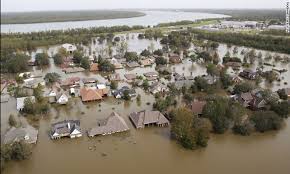
The real estate data firm Zillow recently published a research analysis that estimated rising sea levels could leave nearly 2 million U.S. homes inundated by 2100, a fate that would displace millions of people and result in property losses in the hundreds of billions of dollars.
More than 100,000 of those homes would be in Maryland and Virginia, according to the analysis. Another 140,000 would be submerged in the Carolinas. And Florida would face the gravest scenario of any state, with one in eight properties in danger of being underwater.
For the moment, let’s leave aside the larger debate about how much the water actually will rise. Zillow’s worst-case scenario is based on a study in which scientists projected that sea levels could be six feet higher by the end of this century – nearly twice as much as previously predicted – if carbon dioxide emissions continue unabated. Sharp cuts in greenhouse gas emissions in coming decades could lessen the impact, however, leaving the increase closer to two feet. And constructed barriers and flood-prevention efforts would help minimize the risk in some areas.
Yet there’s near-unanimous agreement among scientists that the seas will rise. Insurance companies are anticipating it. Some cities are already planning for it.
“This is going to be a massive issue worldwide,” Michael Gerrard of Columbia University, who directs the Sabin Center for Climate Change Law, told The Post in a recent interview. “We don’t know yet the exact pace, but we know it’s coming. A certain amount is unavoidable.”
Back to the Zillow report. The company used maps released by the National Oceanic and Atmospheric Administration to determine what coastal areas would be inundated. The firm then used its nationwide database to determine which properties were most at risk of being flooded – at least on the ground level – by the next century.
The results are grim. With six feet of sea level rise, nearly 2 percent of all U.S. housing stock could vanish, accounting for roughly $882 billion worth of homes.
“Based on our calculations, it may turn out that actual water poses almost as much of a problem for the housing market in the future as negative equity has in the past,” wrote Krishna Rao, Zillow’s director of economic product and research.
While scientists will continue to quibble over the degree of change and problems, most agree that both will only grow over time. Benjamin Strauss, director of the program on sea-level rise at Climate Central, an independent organization of scientists based in New Jersey, said that means now is the time for nations to aggressively cut their carbon emissions and explore plans to protect waterfront communities.
“If we don’t do something,” he said, “we’re paving the way for a lot of hurt in the future.”
(c) 2016, The Washington Post · Brady Dennis
{Matzav.com}











At least they slowed down the pace for this to happen. I remember in the 1980s reading about how by 2020 the average July temperature will be over one hundred degrees.
I do not understand why all the Manhattan liberals who are such believers in global warming aren’t doing anything to protect Manhattan from when they believe it will be covered by water.
Perhaps their political efforts will work out but they should also be working on a contingency plan.
Don’t worry – Moshiach will be there by then,
FOR SHURE!!!
According to these computer models, we should have been under water 10 years ago. There is no evidence of global warming other than these computer models, which are obviously wrong since we are not under water. There is nothing scientific about global warming – all pure fascist socialist political games.
Anyone who believes this global warming or man made climate change hypocrisy, is an עם הארץ .
Oh NO!!! Global Drowning!!!